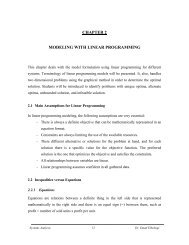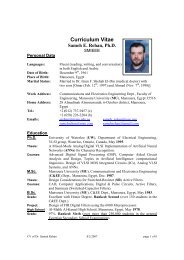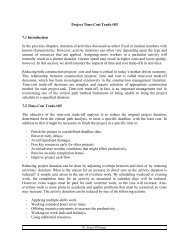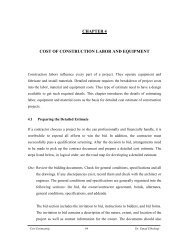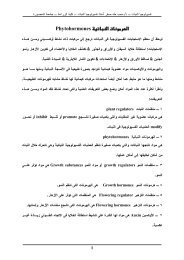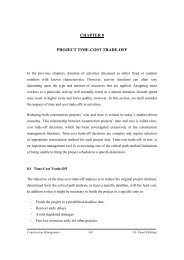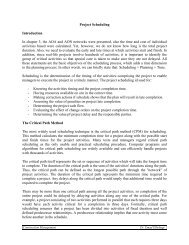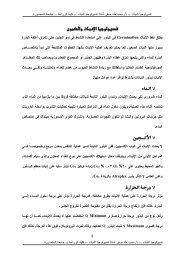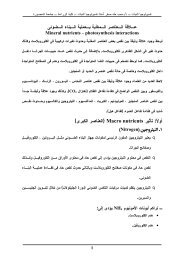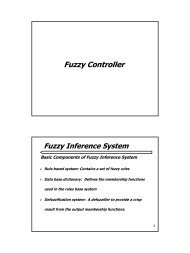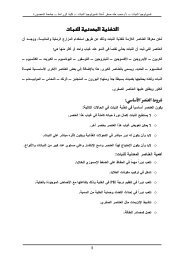SURGICAL INSTRUMENTS
SURGICAL INSTRUMENTS
SURGICAL INSTRUMENTS
Create successful ePaper yourself
Turn your PDF publications into a flip-book with our unique Google optimized e-Paper software.
<strong>SURGICAL</strong> <strong>INSTRUMENTS</strong><br />
The basic instruments that every beginner surgeon<br />
should know are placed in four categories.<br />
1-Cutting and Dissecting<br />
2-Clamping and Occluding<br />
3-Grasping and Holding<br />
4-Retracting and Exposing<br />
1. Cutting and Dissecting instruments<br />
7 handle with 15 blade (deep knife) - Used to cut deep,<br />
delicate tissue.<br />
3 handle with 10 blade (inside knife) - Used to cut<br />
superficial tissue.
4 handle with 20 blade (skin knife) - Used to cut skin.<br />
Straight Mayo scissors -<br />
Used to cut suture and supplies. Also known as: Suture<br />
scissors.<br />
EX: Straight Mayo scissors<br />
being used to cut suture.<br />
Curved Mayo scissors -<br />
Used to cut heavy tissue (fascia,<br />
muscle, uterus, breast).<br />
Available in regular and long sizes.
Metzenbaum scissors -<br />
Used to cut delicatetissue.<br />
Available in regular and long sizes.<br />
2. Clamping and Occluding Instruments<br />
Clamping and occluding instruments are<br />
used to compress blood vessels or hollow organs for<br />
hemostasis or to prevent spillage of contents.
A hemostat<br />
is used to clamp blood vessels or tag sutures.<br />
Its jaws may be straight or curved.<br />
Other names: crile, snap or stat<br />
A mosquito<br />
is used to clamp small blood vessels.<br />
Its jaws may be straight or curved.
A Kelly<br />
is used to clamp larger vessels and tissue.<br />
Available in short and long sizes.<br />
Other names: Rochester Pean<br />
A burlisher<br />
is used to clamp deep blood vessels. Burlishers<br />
have two closed finger rings. Burlishers with an open finger<br />
ring are called tonsil hemostats.<br />
Other names: Schnidt tonsil forcep, Adson forcep<br />
A right angle<br />
is used to clamp hard-to-reach vessels<br />
and to place sutures behind or around a vessel.<br />
A right angle with a suture attached is called a "tie on a<br />
Passer†.<br />
Other names: Mixter
A hemoclip applier with hemoclips<br />
applies metal clips onto blood vessels and ducts which will<br />
remain occluded<br />
3. Grasping and Holding instruments<br />
Grasping and holding instruments are used to hold tissue,<br />
drapes or sponges.
An Allis<br />
is used to grasp tissue. Available in short and long sizes.<br />
"Judd-Allis" holds intestinal tissue;<br />
"heavy allis“ holds breast tissue.<br />
A Babcock<br />
is used to grasp delicate tissue (intestine,<br />
fallopian tube, ovary).<br />
Available in short and long sizes<br />
A Kocher<br />
is used to grasp heavy tissue. May also be used as a clamp.<br />
The jaws may be straight or curved.<br />
Other names: Ochsner.
A Foerster sponge stick<br />
is used to grasp sponges.<br />
Other names: sponge forcep.<br />
EX: Sponge sticks holding a 4 X 4 and probang<br />
A dissector<br />
is used to hold a peanut.<br />
EX: Dissector holding a peanut.
A Backhaus towel clip<br />
is used to hold towels and drapes in place.<br />
Other name: towel clip.<br />
Pick ups, thumb forceps and tissue forceps are available<br />
in various lengths, with or without teeth, and smooth or<br />
serrated jaws.<br />
Russian tissue forceps are used to grasp tissue<br />
Adson pick ups are either smooth: used to grasp delicate<br />
tissue<br />
or with teeth: used to grasp the skin. Other names: Dura<br />
forceps.
Adson pick ups are either smooth: used to grasp delicate<br />
tissue;<br />
or with teeth: used to grasp the skin.<br />
Other names: Dura forceps.<br />
DeBakey forceps are used to grasp delicate tissue,<br />
particularly in cardiovascular surgery.<br />
Thumb forceps are used to grasp tough tissue (fascia,<br />
breast).<br />
Forceps may either have many teeth or a single tooth.<br />
Single tooth forceps are also called "rat tooth forceps."
Mayo-Hegar needle holders<br />
are used to hold needles<br />
They may also be placed in the sewing category.<br />
EX: Needle holder with suture<br />
4. Retracting and Exposing instruments<br />
Retracting and exposing instruments are used to<br />
hold back or retract organs or tissue to gain exposure to<br />
the operative site.<br />
They are either "self-retaining" (stay open on their own)<br />
or "manual" (held by hand).<br />
When identifying retractors,look at the blade, not the<br />
handle.<br />
A Deaver retractor (manual)<br />
is used to retract deep abdominal or chest incisions.
Available in various widths.<br />
A Richardson retractor (manual)<br />
is used to retract deep abdominal or chest incisions.<br />
An Army-Navy retractor (manual)<br />
is used to retract shallow or superficial incisions.<br />
Other names: USA, US Army<br />
A goulet (manual)<br />
is used to retract shallow or superficial incisions.
A malleable or ribbon retractor (manual)<br />
is used to retract deep wounds.<br />
May be bent to various shapes.<br />
A Weitlaner retractor (self-retaining)<br />
is used to retract shallow incisions.<br />
A Gelpi retractor (self-retaining)<br />
is used to retract shallow incisions.<br />
A Balfour with bladder blade (self-retaining)<br />
is used to retract wound edges during deep abdominal
procedures.



